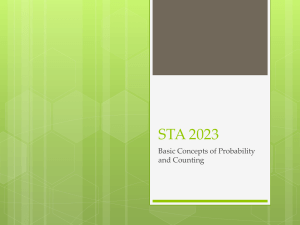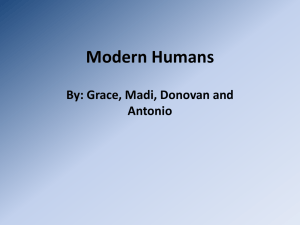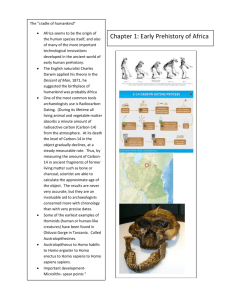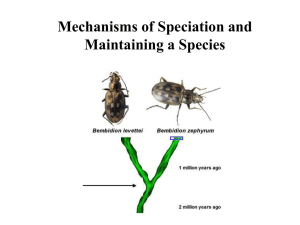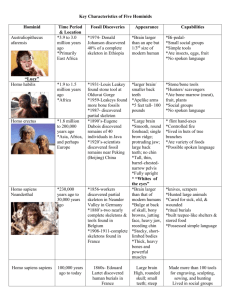T-Test Pan paniscus and Homo sapiens
advertisement
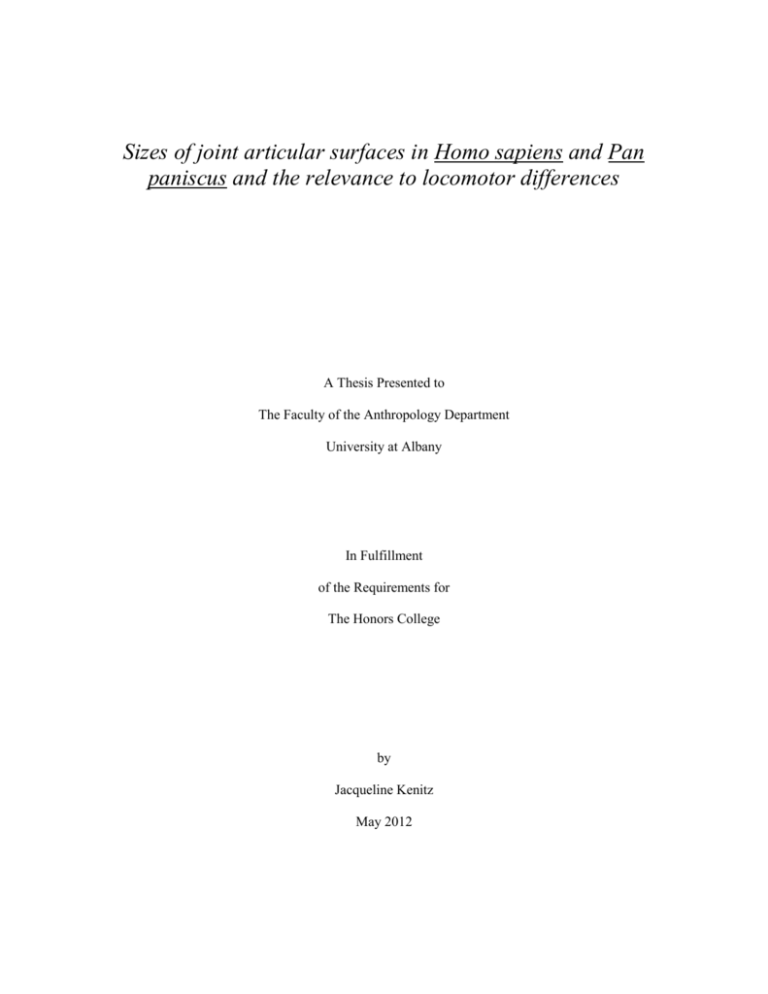
Sizes of joint articular surfaces in Homo sapiens and Pan paniscus and the relevance to locomotor differences A Thesis Presented to The Faculty of the Anthropology Department University at Albany In Fulfillment of the Requirements for The Honors College by Jacqueline Kenitz May 2012 Table Of Contents Title Page Title Page ………………………………………………………………………………………….i Table of Contents ………………………………………………………………………………...ii Introduction ……………………………………………………………………………………….1 Prediction ………………………………………………………………………………..1-2 Background Information ………………………………………………………………………..2 Pan paniscus …………………………………………………………………………….3-4 Homo sapiens …………………………………………………………………………...4 Quadrupedalism ………………………………………………………………………..5 Suspensory ………………………………………………………………………………5 Bipedalism ……………………………………………………………………………..6-7 Methodology ……………………………………………………………………………………..7 Sample …………………………………………………………………………………..7 Data Collection ………………………………………………………………………..7-8 Analysis …………………………………………………………………………………8-9 Results …………………………………………………………………………………………...9 Discussion ………………………………………………………………………………………15 Conclusion ……………………………………………………………………………………..17 References ……………………………………………………………………………………..18-19 Appendix ……………………………………………………………………………………….20-29 Proximal Femur Pan paniscus …………………………………………………….20 Distal Femur Pan paniscus ………………………………………………………..21 Proximal Humerus Pan paniscus …………………………………………………22 Distal Humerus Pan paniscus …………………………………………………….22-23 Proximal Femur Homo sapiens…………………………………………………...23 Distal Femur Homo sapiens ………………………………………………………24 Proximal Humerus Homo sapiens ……………………………………………….24-25 Distal Humerus Homo sapiens……………………………………………………25-246 Proximal Log Ratios Pan paniscus ……………………………………………..26 Proximal Log Ratios Homo sapiens …………………………………………….27 Distal Log Ratios Pan paniscus …………………………………………………27-28 Distal Log Ratios Homo sapiens ………………………………………………..28-29 T-Test Pan paniscus and Homo sapiens ……………………………………….29 Introduction: Differences in locomotion have always presented interest in the anthropological field because of large differences found between similar species. By examining the proximal and distal femoral and humeral heads of Homo sapiens and Pan paniscus, we are able to see the differential distribution of body weight, and how that compares to that particular species locomotion. Locomotion patterns of bonobos, Pan paniscus, include quadrupedal knuckle walking, suspensory movement under branches and occasional instances of bipedalism. However, humans, Homo sapiens, are known to be strictly bipedal using no other forms of locomotion. Many believe that habitual bipedalism evolved from an arboreal species like bonobos and chimpanzees that commonly used postural bipedalism when foraging or navigating through tree branches. Every type of locomotion has its own unique physical attributes that by simply examining bone samples one could determine what type of locomotion is present in that certain species. With further comparison of the bones of Pan paniscus and Homo sapiens, there is hope to find a correlation between the many proposed evolutionary theories. In order to find differences in the locomotion patterns and joint articular surfaces of humans and bonobos, two predictions were tested. The first predication was that the human would have a much larger distal and proximal femoral and humeral head surfaces in comparison to the bonobo because the human is larger in size relative to the bonobo. This would also be true because most, if not all, of the weight is passed through the lower limbs while moving bipedally. The proximal and distal surfaces of the humeral head would be much smaller, because very little, if any mass is passed through the upper limbs in humans. The articular surfaces of humerus may not be as small as believed because humans carry large objects that would require having large bone surfaces to provide more space for muscle attachment. Overall, it is predicted that for Homo sapiens at any given femur size they will have a smaller humeral head relative to Pan paniscus. The second prediction is that Pan paniscus will have both smaller proximal and distal humeral and femoral heads with respect to the human because they have a smaller mass. Also, these two measurements may be very similar in size because while moving quadrupedally, as bonobos do, body weight is evenly distributed throughout both the upper and lower limbs. By scaling body size, it is possible that we will see bonobos having larger upper limb measurements, as they typically make use of these limbs for a greater amount of time compared to Homo sapiens. The study that has been done will relate Homo sapiens and Pan paniscus in order to account for the differences in body mass as well as locomotor differences and how the joint articular surfaces of the upper and lower limbs affect these differences. Background Literature: Locomotion is the act of moving from one place to another while keeping the body in equilibrium (Prost, 1967). Primates vary in locomotion patterns from arboreality, terresteriality, bipedalism, quadrupedalism, suspensory, vertical clinging and leaping, and just about everything in-between. Primates that are able to move freely about their habitat are able to participate in a variety of different kind of locomotor patterns, granted their bodies are adapted for it (Devine, 1985). Many times the locomotion pattern of the primate is dependent upon the behavior of primate such as the food it consumes, its environment, and its body size. When discussing locomotion, there are two parts, one is the particular activity and the second is where the activity takes place, or the substrate (Prost, 1967). For example, if a primate is an arboreal quadruped such as Pan paniscus, its locomotor activity is suspensory brachiation that occurs in the trees, and is predominately a knuckle-walker on the ground. Locomotion is also very dependent upon the physical makeup of the primate, such as the muscles, bone, and organs it is comprised of (Prost, 1967). Larger bones and muscles are required to move a larger bodied primate, while more restricted joints are necessary in quadrupedal primates as opposed to suspensory and brachiating primates. Locomotion has a wide range of variety across the primate spectra, but is dependent on many factors including environment, body adaptations, and behavioral patterns. The first primate species that was researched was Pan paniscus, or the bonobo. In many ways, bonobos are quite similar to Homo sapiens, and may be thought of as the link to the evolutionary mystery of humans. They typically live in fission-fusion social groups which means, they are a large community that separates during the day into smaller groups for foraging and variety of other reasons and returns together in the eve, (Cawthon, 2010). “The bonobo can be characterized as a female-centered, equalitarian primate species that substitutes sex for aggression,” (De Waal, 1997, p. 1). Rates of sexual activity in this group of primates are very high; however, the rate of reproduction does not reflect the high sexual activity rate. Due to the high rates of sexual activity in the bonobo society, there is regularly paternal uncertainty when a female becomes pregnant (Cawthon, 2010). Typically, the bonobo is a habitual quadruped, or knuckle-walker, with some instances of postural bipedality (Videan and McGrew, 2002). Bonobos, once known as the pygmy chimpanzee on average weigh from 45 kg in males and 33.2 kg in females (Smith and Jungers, 1997). “To support their weight bonobos are skeletally created more for bipedalism than other ape relatives because of their longer femoral bones, larger tarsal and metatarsal bones, centrally positioned foramen magnum, and weight distribution, but typically move as knuckle-walkers,” (Cawthon, 2010, web pg.1). As compared to the common chimpanzee, bonobos act quite differently. The bonobos are sensitive and timid, physical violence is rarely seen, and bonobos are more vocal than chimpanzee and commonly raise and wave their hands while calling (De Waal, 1997). These behaviors are unique to bonobos, and are typically not even seen in sister taxa such as Pan troglodytes. Bonobo as well as the common chimpanzee is the closest extant relative to Homo sapiens. Analyses of the movement and bone structure of the bonobo may lead to missing pieces in the unsolved evolutionary puzzle of the bipedality of human beings. Homo sapiens also have many characteristics that are unique to the species. To be human means to have enlarged brains, upright walking, extensive and versatile language, and a social life including many members (Koch, 2102). The brain began to increase in size when the early humans began using stone tools and walking bipedally. Then with a change in climate, brain size increased rapidly to allow for interaction and survival, (Koch, 2012). From extensive research that has been done we now can assume that hominids were present both in arboreal climbing settings, as well as terrestrial bipedalism (Thorpe, et al., 2007). The average weight of Homo sapiens ranges from 62.1-72.1 kg, with a wide variety across the species, (Smith and Jungers, 1997). To support this larger body and the locomotor adaptions, approximately “1.89 million years the development of the long thigh bone of Homo erectus allowed it to take long strides and therefore walk farther than earlier hominids,” (Koch, n.d.). Bipedalism is one of the very important characteristics of present day humans as it unique to Homo sapiens. An enlarged brain and two-legged movement allowed this primate species to travel longer distances, freed their hands for food and infant carrying, and allowed them to scare of predators appearing bigger and more astounding. With these new characteristics that were developed, they were able to survive longer thus passing these traits on subsequent generations. Although it is unknown exactly how or why bipedalism evolved when it did, analysis of past and present day humans have led to further insight on the topic. Quadrupedalism is a locomotor pattern striding with all four limbs placed on the ground. Bonobos typically use quadrupedalism as their main source of locomotion; however, studies have been done that prove they commonly use postural bipedalism when moving on branches and foraging for food. While locomoting quadrupedally, bonobos typically have a diagonalsequence walk, seen in other primates (De Auot, et. al., 2004). When moving at a very brisk pace, bonobos appear to gallop, leading to a large amount of unnecessary stress on the fore and hindlimbs (De Auot, et al., 2004).This kind of walking experienced by bonobos and chimpanzees alike, is seemingly quite energetically inefficient, possibly leading to the development of bipedalism in early hominid species, (Sockol, et al., 2007). When moving arboreally, bonobos use a bent-hip, bent- knee posture that is less ineffective energetically than a human stance (Carey and Crompton, 2005). When walking quadrupedally, bonobos use larger steps and shorter frequency than when walking bipedally, using shorter steps but a greater frequency (De Auot et al., 2004). Many anthropologists of the past and present believe that the bipedalism of present day humans evolved from the gait of bonobos and chimpanzees. Another form of locomotion practiced by Pan paniscus is suspensory movement in which the primate uses its forelimbs to swing below the branches as opposed to sitting on top of them. Although chimpanzees and bonobos alike most greatly rely on their hindlimbs to move them from place and their forelimbs solely as a prop, the forelimbs are adapted for general propelling behaviors, (Myatt et. al., 2012). These adaptations include a large range of motion in the shoulder joints, long extended phalanges to wrap around the branches, and opposable thumbs to name a few. Suspensory movement is not the most prominent movement since in only occurs in the trees, but should be accounted for as it may affect the size of the proximal and distal surfaces of the humerus. Bipedalism is known as walking upright on two hind limbs for an extended period of time, practiced today by all modern humans as well as select primates and other animals. “Bipedalism is the defining feature of the earliest hominids, and marks the divergence from other apes,” (Sockol et al., 2007). Many people have created hypotheses for the evolution of bipedalism from tool use to thermoregulation, and carrying to locomotor efficiency (Videan and McGrew, 2002). However, bipedalism developed far before the enlargement of the brain or any use of stone tools, told by the fossil record. It is important to make note that the “bipedalism” practiced by early hominids such as Lucy and other members Australopithecus afarensis, was not the same “bipedalism” practiced by modern Homo sapiens. Skeletal features such as a shorter hind limb in Lucy suggest that this species was not as fully adapted to walk on two limbs as are modern humans (Lewin, 1983). In order to be able to support to the body on only two limbs and walk upright, a variety of skeletal features must be demonstrated for structural and balance purposes. Some of these adaptions include the bicondylar angle, pelvic structure, and femoral attributes, and joint surfaces. Christopher Ruff stated the “modern adult humans are distinct from most other primates in having relatively very long and strong lower limb bones compared to upper limb bones,” (Ruff, 2003). Research was done that found differences in the bicondylar angle of moderns, australopithecines, and chimpanzees. The angle in modern humans ranges from 8-11 degrees, 14-15 degrees in australopithecines, and from 1-5 degrees in chimpanzees (Shefelbine, et al., 2002). This can be accounted for by loading and locomotor patterns, and size of the rest of the body. These implications allow the modern human to not only stand upright, but also walk on two limbs while keepings its posture and balance. “While bipedalism may not be uniquely human, walking is,” (Marks, 1987). Bipedalism has come a long way from our chimpanzee ancestors to early hominids and as advanced as walking and running in modern humans. While humans may be self-consciously bipedal today, it must have originated from sometime in the past (Devine, 1985). The question you may be asking yourself is where does bipedalism evolve from? Or has it been practiced far longer than the fossil record suggests? While there is indeed an agreement between bipedalism characterizing earliest hominids, there is much less of an agreement about how it evolved, (Richmond et al., 2001). Measuring the articular joint surfaces of the bonobo and human may give better indication about the last common ancestor of the human, bonobo, and chimpanzee. Methodology Sample: Bones of Pan paniscus and Homo sapiens were collected and photographs were taken by Adam Gordon, Ph.D. Each photograph was taken in a similar fashion, resting upon a flat surface with a ruler on the side of picture for scaling purposes. The Pan panicus bones were collected from the Royal Museum of Central Africa located in Tervuren, Belgium. Photographs were taken of the proximal femoral and humeral joint articular surfaces and also the distal femoral and humeral joint articular surfaces. The Homo sapiens bones were photographed from the HamannTodd Osteological Collection dated from 1960-1976 located in the The Cleveland Museum of Natural History. Data Collection: After the photographs were taken, the pictures were transferred on the laboratory computers for further analysis. Once the photographs were received, measurements began on the joint articulation surfaces using a program called Image J. First, I choose the straight line selection option was chosen from Image J and a scale was picked on the ruler, typically from about 10 mm to 80 or 90 mm, depending on the size of the bone. Then, the analyze function was chosen, set scale and the known distance box placed the “known distance” of typically about 70 or 80 mm (90/80 mm – 10mm), and selected OK. After zooming into the picture to get as close as possible, the measurements began. Using the polygon selection tool, points around the articulate surface were clicked to outline the bone as well as possible. Under the analyze tool was a function called measurement, that was chosen given the area of the joint articulation surface in mm2. This was done for each bone and each specimen, and both the distal and proximal ends. After an initial run through was completed, the above process was done again a second and third time to ensure accuracy and precision of the data. A total of thirty-two Homo sapiens distal and proximal humeri were measured, not including two extra photographs that were taken to see other angles of the distal humerus. There were also thirty-two Homo sapiens distal and proximal femurs that were measured. For Pan paniscus, there were each a total of twenty-three distal and proximal humeral and femoral heads that were measured. However, MRAC 29048, MRAC 29056, and MRAC 29058 were removed from the analyses because they were previously determined to be juveniles, but will be included in the large sample size. Analysis: All data were collaborated into an Excel file, averages were taken for each specimen. After the average was taken, each of the three runs was compared to the average, for a percentage error, (((measured-actual)/actual) *100). If the percentage error was over 2%, the specimen was ultimately re-measured for a fourth data point to try to receive more accurate data. However, if the percent error was over 5%, that particular measurement was thrown away as it was too inaccurate to be considered in the data set. After the percentage errors were run on data, log values were run to better compare the bone sizes with differing body sizes. Finally, a simple regression was done to compare the distal femoral head and distal humeral head, and also the proximal femoral and humeral heads. On the same graph, plots were made of the log of the proximal femur to the log of the proximal humerus for both the human and bonobos. This was also done for the distal ends of the femur and humerus. Log ratios were found using techniques on Excel, log(proximal humerus/proximal femur) and log(distal humerus/distal femur) for both Pan paniscus and Homo sapiens. This value was graphed against either one or two to compare results of each species. Finally, a t-test was run on the data, a two sample test assuming equal variances, and the results were gathered for each articular surface of each species. Results: After measuring and analyzing the bone specimen of Pan paniscus, the minimum, maximum, and average absolute value of intra-observer error for each of the joint articular surfaces were calculated, and recorded in percentages. See table one below. Pan paniscus Bone Proximal Femur Distal Femur Proximal Humerus Distal Humerus Average abs value Minimum Error Maximum Error 0.28 -0.94 0.73 0.66 -2.31 2.61 0.51 -1.55 2.29 0.36 -1.14 1.3 Table 1: Error for Articular Surfaces for Pan paniscus Based upon the calculations of error, all of these values can be accepted and used for further analysis. After the measurements were completed, these results were further analyzed using least squares regression. First, I compared log proximal femur to log of proximal humerus and found the following, see table 2. Intercept LOG FP Coeff 0.585 0.839 Standard Error 0.462 0.161 t Stat 1.266 5.220 P-value 0.222 0.000 Lower 95% -0.386 0.501 Upper 95% 1.556 1.177 Lower 95.0% -0.386 0.501 Upper 95.0% 1.556 1.177 Table 2: Least Squares Regression Analysis Comparing Proximal Femur to Proximal Humerus in Pan paniscus The results have been graphed as seen in figure 1 below. log FP Line Fit Plot 3.1 log HP 3.05 3 LOG HP 2.95 Predicted LOG HP 2.9 2.85 2.75 2.8 2.85 2.9 2.95 3 log FP Figure 1: Least Squares Regression Comparing Proximal Femur and Humerus in Pan paniscus Then, the distal femur and humerus were compared in a least squares regression analysis, and the results are show below in table three. Coefficients Standard Error t Stat Pvalue Lower 95% Upper 95% Lower 95.0% Upper 95.0% Intercept -0.121 0.237 -0.511 0.615 -0.614 0.372 -0.614 0.372 LOG FD 0.953 0.077 12.317 <0.001 0.792 1.114 0.792 1.114 Table 3: Least Squares Regression Analysis Comparing Distal Femur to Distal Humerus in Pan paniscus The above information has been generated in to a graph by Excel and can be graphically viewed below in figure two. log FD Line Fit Plot 3 2.9 logHD 2.8 2.7 Log HD 2.6 Predicted Log HD 2.5 2.4 2.7 2.8 2.9 3 3.1 3.2 3.3 log FD Figure 2: Least Squares Regression Comparing Distal Femur and Humerus in Pan paniscus Intra-observer error was also found for Homo sapiens for each articular surfaces, proximal femur and humerus, and distal femur and humerus. Results can be seen below in table four. Homo sapiens Bone Proximal Femur Average abs value Minimum Error Maximum Error 0.23 -0.86 0.61 0.5 -1.91 1.93 Proximal Humerus 0.39 -1.32 1.72 Distal Humerus 0.48 -1.5 2.01 Distal Femur Table 4: Error for Articular Surfaces for Homo sapiens After reviewing the minimum, maximum, and average absolute value of errors for each surface, all of these values can be accepted and used again for further analysis. Again, a least squares regression analysis was run on the data, and the information below in table five was what was gathered. Standard Error 0.181 0.056 Coefficients 0.191 0.927 Intercept Log FP t Stat 1.056 16.533 P-value 0.299 0.000 Lower 95% -0.178 0.813 Upper 95% 0.561 1.042 Lower 80.0% -0.046 0.854 Upper 80.0% 0.428 1.001 Table 5: Least Squares Regression Analysis Comparing Proximal Femur to Proximal Humerus in Homo sapiens The above information can be found on figure three below, a graph generated by Excel. Log FP Line Fit Plot 3.4 Log HP 3.3 3.2 Log HP 3.1 Predicted Log HP 3 2.9 3 3.05 3.1 3.15 3.2 3.25 3.3 3.35 3.4 3.45 Log FP Figure 3: Least Squares Regression Comparing Proximal Femur and Humerus for Homo sapiens Finally, one last regression was run on the distal femur and humerus of Homo sapiens, the information below in table six. Coefficients Intercept Log FD Standard Error t Stat P-value Lower 95% Upper 95% Lower 80.0% Upper 80.0% -0.820 0.258 -3.181 0.003 -1.346 -0.293 -1.157 -0.482 1.066 0.073 14.515 0.000 0.916 1.217 0.970 1.163 Table 6: Least Squares Regression Analysis Comparing Distal Femur to Distal Humerus in Homo sapiens This information above is further explained in the graph generated by Excel below in figure 4. Log FD Line Fit Plot Log HD 3.1 3 2.9 Log HD 2.8 Predicted Log HD 2.7 3.35 3.4 3.45 3.5 3.55 3.6 3.65 Log FD Figure 3: Least Squares Regression Comparing Distal Femur and Humerus for Homo sapiens After the least squares regression was completed, a log function was run on each of the species, and log ratios were calculated, log (promixal humerus/proximal femur) for bonobos and humans, and log (distal humerus/distal femur) for bonobos and humans, as seen in tables ninetwelve in the appendix. Finally, a t-test assuming equal variances was run on the data. For the proximal femur and humerus ratio, the mean value for Pan paniscus is 0.123 and is -0.044 for Homo sapiens. The t-stat is 18.720 and the P one-tail is < 0.001. For the t-test comparing the distal femur and humerus the mean for Pan paniscus -0.261 and is -0.587 for Homo sapiens. The t-stat is 32.049 and the P one-tail is < 0.001, and can be referred to in table thirteen and fourteen in the appendix. Finally, the log ratios of theproximal femur and proximal humerus for both Pan paniscus and Homo sapiens were compared and graphed together, below. 3.4 3.3 log HP 3.2 Pan paniscus 3.1 Homo sapiens Linear (Pan paniscus) 3 Linear (Homo sapiens) 2.9 2.8 2.7 2.8 2.9 3 3.1 3.2 3.3 3.4 3.5 log FP Figure 5: Comparing Log Ratios of Proximal Femur and Humerus for Pan paniscus and Homo sapiens The log ratios for the distal surfaces of the femur and humerus for Pan paniscus and Homo sapiens were also compared, seen below in figure six. 3.18 log HD 3.08 2.98 Pan paniscus 2.88 Homo sapiens Linear (Pan paniscus) 2.78 Linear (Homo sapiens) 2.68 2.5 2.7 2.9 3.1 3.3 3.5 3.7 log FD Figure 6: Comparing Log Ratios of Distal Femur and Humerus for Pan paniscus and Homo sapiens The information provided to us by figures five and six will either support or not support the initial predictions. Discussion: The results found above are consistent with the initial prediction in that disregarding size of the primate, the forelimb in Pan paniscus is smaller in relationship to Homo sapiens because the body size of Homo sapiens is larger than the body size of Pan paniscus. Further analysis of the least squares regression for proximal femur and proximal humerus of the Pan paniscus, it is seen that the slope does not differ significantly from isometry at alpha=0.05. For the distal femur and humerus for the same species, the slope also does not differ significantly from isometry at alpha =0.05. From this it can be gathered that, these values do not drastically change in retrospect to size, but rather stay constant to the size of the primate throughout the species. For the Homo sapiens species, similar results have been found. For both the distal and proximal femur and humeral articulation areas, the slope does not differ significantly from isometry at alpha = 0.05. This means the larger the human, the larger the femur and humeral heads of the person. For example, one would not see a 6’5’’ human with the same sized femoral heads as a 4’11’’ person. But, this also means that the ratio if proximal humerus to proximal femur doesn’t change within a given species, regardless of size (i.e, same ratio for 6’5’’ and 4’11’’.) After discussing the isometry of the two species, valuable information has been uncovered. After comparing the log ratios for the proximal ends of the femur and humerus for both Pan paniscus and Homo sapiens, it has been noted for primates of similar sizes, Pan paniscus has both a larger proximal femur and humerus, which can been seen in figure 5. Therefore, at any given proximal femur size, it can be expected that Pan paniscus will have a larger proximal humeral size. This agrees with the initial prediction made since Pan paniscus pass more weight through their forelimbs while moving quadrupedally, it is expected they should have larger forelimb measurements in comparison to Homo sapiens, which only use their hind limbs for movement. The same holds constant for the distal humerus and femur for Pan paniscus and Homo sapiens. It has been found that for any distal femur size, the distal humerus for Pan paniscus is much larger. This also agrees with the initial prediction in that primates who use all four limbs to move would be expected to have larger forelimb measurements, than primates who only use their hind limbs for locomotor purposes. The graph explaining the above data can be seen in figure six above. The one-tailed t-test that was used as it compares two different populations. The information gathered from this test showed that these two species were definitely from two different populations. This information can be gathered due to the large value of the t-stat. It was found that the ratio between the distal humerus and the distal femur produced a greater t-statistic. This gives us the information that there is a greater separation in the sizes of the distal articulation surfaces in comparison to the proximal articular surfaces. Further work can be done to test why locomotion may affect the distal surfaces more significantly than the proximal surfaces of both the humerus and femur. Conclusion: In conclusion, my initial predication was supported that morphology does indeed reflect locomotion. This experiment has found that passing weight through four limbs makes for larger sized humeral heads to support the moving primate. On the opposing side, a primate must have larger femoral measurements if he/she is only passing weight through the hind limbs. The limbs must be large enough the support the weight passing through them, but not too large as to compromise the movement of the species. All of the evidence supports the prediction that if a species uses forelimbs as well as hind limbs as in quadrupedal movement to locomote, they should indeed have larger forelimbs relative to hindlimbs than a species that does not use their forelimbs for the same purpose. Both Pan paniscus and Homo sapiens have specialized morphological details that effect their locomotor preferences as well as where and how it is performed. References Cited: 1. Carey, T.S., Crompton, R.H. (2005). The metabolic costs of “bent-hip, bent-knee” walking in humans. J of Hum Evo, 48(1), 25-44. 2. Cawthon, Lang KA. 2010 December 1. Primate Factsheets: Bonobo (Pan paniscus) Behavior. http://pin.primate.wisc.edu/factsheets/entry/bonobo/20ehave. Accessed 2011 November 21. 3. D Auot, K., Vereecke, E.,Schooanaert, K., De Clercq, D., Van Elsacker, L., Aerts, P. (2004). Locomotion in bonobos (Pan paniscus): differences and similarities between bipedal and quadrupedal terrestrial walking, and a comparison with other locomotor modes. J of Anat, 204(5), 353-361. 4. Devine, J. (1985). The versatility of human locomotion. American anthropologist, 87(3), 550-70. 5. De Waal Frans. 1997. Bonobo: The Forgotten Ape. University of California Press Chapter 1. 1-1. 6. Harmon, E.H. (2007). The shape of the hominoid proximal femur: A geometric morphometric analysis. J of Anat., 210(2), 170-185. 7. Koch, D. H. (2012). What does it mean to be human? Retrieved from http://humanorigins.si.edu/human-characteristics. Accessed 2011 November 28. 8. Lewin, R. (1983). Do ape-size legs mean ape-like gait? Science, 221, 537-38. 9. Marks J. 1987. Bipedal Locomotion. Science 236: 1412. 10. Prost JH. 1967. A definitional system for the classification of primate locomotion. American Anthropologist 67: 1198-1214 11. Richmond, B., Begun, D.R., Strait, D.S., (2001). Origin of human bipedalism: the knuckle-walking hypothesis revisited. Yearbook of Physical Anthropology, 44, 70-105. 12. Ruff, C., (2003). Ontogenetic adaptions to bipedalism: age changes in femoral to humeral length and strength proportions in humans, with a comparison to baboons. Journal of Human Evolution, 45(4), 317-349. 13. Shefelbine, S.J., Tardieu, C., Carter, D.R. (2002). Development of the femoral bicondylar angle in hominid bipedalism. Bone, 30(5), 765-770 14. Smith, R., and Jungers, W. (1997). Body mass in comparative primatology, Journal of Human Evolution, 32, 523-559. 15. Sockol, M. D., Raichlen, D. A., & Pontzer, H. (2007). Chimpanzee locomotor energetics and the origin of human bipedalism. PNAS, 104(30), 12265-12269. 16. Thorpe, S. S., Holder, R. L., & Crompton, R. H. (2007). Origin of human bipedalism: As an adaption for locomotion on flexible branches. Science, 316, 1328-1331. 17. Videan E.N, McGrew W.C. 2002. Bipedality in Chimpanzee (Pan tyoglodytes) and Bonobo(Pan paniscus): Testing hypotheses on the Evolution of Bipedalism. American J of Phys Anthro 118: 184-190. Appendix Specimen MRAC 13202 MRAC 15293 MRAC 15294 MRAC 15295 MRAC 15296 MRAC 27696 MRAC 27698 MRAC 27699 MRAC 29035 MRAC 29040 MRAC 29042 MRAC 29044 MRAC 29045 MRAC 29045 MRAC 29045 MRAC 29047 MRAC 29048 MRAC 29051 MRAC 29051 MRAC 29051 MRAC 29052 MRAC 29053 MRAC 29054 MRAC 29054 MRAC 29056 MRAC 29057 MRAC 29058 MRAC 29060 MRAC 29063 MRAC 84036 MRAC 84036 MRAC84036M Ver. 2 3 1 2 3 1 2 1 Area (sq. mm) – 1st Area (sq. mm) – 2nd 727.520 758.567 765.040 736.838 904.828 857.093 724.802 832.163 730.577 886.620 727.908 708.501 775.557 771.190 765.714 944.029 336.267 633.939 638.064 631.854 758.299 670.706 732.145 733.501 455.127 662.190 491.649 635.458 739.787 1075.914 787.161 578.716 729.275 761.167 764.599 736.533 900.661 858.296 730.844 831.363 738.966 889.021 731.001 711.366 774.005 778.349 770.748 947.864 339.147 637.716 639.702 627.647 760.230 676.537 732.094 728.487 457.014 659.989 491.775 628.122 738.880 1075.725 788.650 581.963 Area (sq. mm) 730.780 762.948 764.574 734.403 901.821 850.735 728.113 827.067 742.890 883.352 721.793 709.031 769.034 775.974 770.325 939.188 336.644 631.311 643.686 626.699 755.608 675.982 728.145 733.873 456.375 654.386 496.451 632.884 736.567 1072.441 790.088 580.811 Mean Measurement % Error 1 % Error 2 % Error 3 729.192 760.894 764.738 735.925 902.437 855.375 727.920 830.198 737.478 886.331 726.901 709.633 772.865 775.171 768.929 943.694 337.353 634.322 640.484 628.733 758.046 674.408 730.795 731.954 456.172 658.855 493.292 632.155 738.411 1074.693 788.633 580.497 -0.23% -0.31% 0.04% 0.12% 0.26% 0.20% -0.43% 0.24% -0.94% 0.03% 0.14% -0.16% 0.35% -0.51% -0.42% 0.04% -0.32% -0.06% -0.38% 0.50% 0.03% -0.55% 0.18% 0.21% -0.23% 0.51% -0.33% 0.52% 0.19% 0.11% -0.19% -0.31% 0.01% 0.04% -0.02% 0.08% -0.20% 0.34% 0.40% 0.14% 0.20% 0.30% 0.56% 0.24% 0.15% 0.41% 0.24% 0.44% 0.53% 0.54% -0.12% -0.17% 0.29% 0.32% 0.18% -0.47% 0.18% 0.17% -0.31% -0.64% 0.06% 0.10% 0.00% 0.25% 0.22% 0.27% -0.02% -0.21% -0.07% -0.54% 0.03% -0.38% 0.73% -0.34% -0.70% -0.08% -0.50% 0.10% 0.18% -0.48% -0.21% -0.47% 0.50% -0.32% -0.32% 0.23% -0.36% 0.26% 0.04% -0.68% 0.64% 0.12% -0.25% -0.21% 0.18% 0.05% Table 1: Measurements of Proximal Femur for Pan paniscus ***MRAC 29048, 29056, and 29058 were removed in the analysis as they were identified as juveniles Specimen Area (sq. mm) Area (sq. mm) Area (sq. mm) Mean Measurement % Error 1 % Error 2 %Error 3 MRAC 13202 MRAC 15293 MRAC 15294 MRAC 15295 MRAC 15296 MRAC 27696 MRAC 27698 MRAC 27699 MRAC 29035 MRAC 29040 MRAC 29042 MRAC 29044 MRAC 29045 MRAC 29047 MRAC 29048 MRAC 29051 MRAC 29052 MRAC 29053 MRAC 29054 MRAC 29056 MRAC 29057 MRAC 29058 MRAC 29060 MRAC 29063 MRAC 84036M MRAC 84036M MRAC 84036M 1643.184 1372.690 1370.018 1193.628 1377.232 1362.732 1142.022 1224.168 1069.762 1373.330 1233.015 1236.555 1318.038 1484.534 554.590 1063.734 1261.662 1035.058 1205.216 769.033 894.901 762.391 1090.153 1259.648 1673.547 1622.816 1371.291 1371.863 1198.135 1397.835 1368.115 1144.011 1236.612 1100.504 1359.688 1231.006 1243.881 1270.671 1473.024 572.358 1077.618 1223.204 999.234 1200.637 773.969 908.697 749.114 1102.782 1253.176 1686.165 1638.300 1377.389 1370.737 1194.681 1419.334 1358.592 1154.474 1230.256 1114.965 1365.196 1227.890 1236.133 1292.011 1472.359 569.552 1068.104 1230.111 991.790 1215.781 759.772 913.002 740.314 1104.913 1227.730 1683.363 1634.767 1373.790 1370.873 1195.481 1398.134 1363.146 1146.836 1230.345 1095.077 1366.071 1230.637 1238.856 1293.573 1476.639 565.500 1069.819 1238.326 1008.694 1207.211 767.591 905.533 750.606 1099.283 1246.851 1681.025 0.51% -0.08% -0.06% -0.16% -1.49% -0.03% -0.42% -0.50% -2.31% 0.53% 0.19% -0.19% 1.89% 0.53% -1.93% -0.57% 1.88% 2.61% -0.17% 0.19% -1.17% 1.57% -0.83% 1.03% -0.44% -0.73% -0.18% 0.07% 0.22% -0.02% 0.36% -0.25% 0.51% 0.50% -0.47% 0.03% 0.41% -1.77% -0.24% 1.21% 0.73% -1.22% -0.94% -0.54% 0.83% 0.35% -0.20% 0.32% 0.51% 0.31% 0.22% 0.26% -0.01% -0.07% 1.52% -0.33% 0.67% -0.01% 1.82% -0.06% -0.22% -0.22% -0.12% -0.29% 0.72% -0.16% -0.66% -1.68% 0.71% -1.02% 0.82% -1.37% 0.51% -1.53% 0.14% 1251.534 1253.290 1235.056 1246.627 0.39% 0.53% -0.93% 1015.693 1030.983 1034.239 1023.338 -0.75% 0.75% 1.07% Table 2: Measurements of the Distal Femur for Pan paniscus ***MRAC 29048, 29056, and 29058 were removed in the analysis as they were identified as juveniles Specimen MRAC 13202 MRAC 15293 MRAC 15294 MRAC 15295 MRAC 15296 MRAC 27696 MRAC 27698 MRAC 29035 MRAC 29040 MRAC 29042 MRAC 29044 MRAC 29045 MRAC 29047 MRAC 29048 MRAC 29051 MRAC 29052 MRAC 29053 MRAC 29054 MRAC 29056 MRAC 29057 MRAC 29058 MRAC 29060 MRAC 29063 Area (sq. mm) 1033.667 1017.986 994.114 1015.565 1127.935 1101.249 939.712 1011.236 1196.029 933.228 1036.727 1137.420 1097.602 309.126 891.583 998.977 802.495 890.837 412.613 761.616 353.506 882.623 1076.715 Area (sq. mm) 1035.274 1024.731 1001.318 1021.988 1130.687 1094.115 935.626 1020.965 1207.564 955.667 1077.182 1152.861 1111.468 307.470 897.496 1002.859 798.785 887.143 411.156 758.109 361.014 880.505 1094.316 Area (sq. mm) 1031.292 1021.261 985.115 1034.518 1112.188 1099.567 937.654 1011.816 1232.384 952.824 1045.220 1147.875 1098.447 306.966 896.693 1002.221 800.530 886.690 408.412 777.603 357.906 883.913 1083.268 Mean Meas 1033.411 1021.326 993.516 1024.024 1123.603 1098.310 937.664 1014.672 1211.992 947.240 1053.043 1146.052 1102.506 307.854 895.257 1001.352 800.603 888.223 410.727 765.776 357.475 882.347 1084.766 % Error 1 % Error 2 % Error 3 0.02% -0.33% 0.06% -0.83% 0.39% 0.27% 0.22% -0.34% -1.32% -1.48% -1.55% -0.75% -0.44% 0.41% -0.41% -0.24% 0.24% 0.29% 0.46% -0.54% -1.11% 0.03% -0.74% 0.18% 0.33% 0.79% -0.20% 0.63% -0.38% -0.22% 0.62% -0.37% 0.89% 2.29% 0.59% 0.81% -0.12% 0.25% 0.15% -0.23% -0.12% 0.10% -1.00% 0.99% -0.21% 0.88% -0.21% -0.01% -0.85% 1.02% -1.02% 0.11% 0.00% -0.28% 1.68% 0.59% -0.74% 0.16% -0.37% -0.29% 0.16% 0.09% -0.01% -0.17% -0.56% 1.54% 0.12% 0.18% -0.14% Table 3: Measurements of the Proximal Humerus for Pan paniscus Specimen MRAC 13202 MRAC 15293 MRAC 15294 MRAC 15295 MRAC 15296 MRAC 27696 MRAC 27698 MRAC 29035 MRAC 29040 MRAC 29042 MRAC 29044 MRAC 29045 MRAC 29047 MRAC 29048 MRAC 29051 MRAC 29052 MRAC 29053 MRAC 29054 Area (sq. mm) – 1st 768.341 693.331 711.847 759.019 723.946 728.878 616.392 644.927 705.762 638.469 635.176 688.173 900.782 296.689 635.694 701.670 600.824 676.969 Area (sq. mm) – 2nd 769.184 697.570 701.123 762.107 726.431 728.969 622.111 629.375 707.977 636.134 638.872 687.638 902.926 296.560 638.582 701.089 598.267 682.392 Area (sq. mm) 763.068 694.540 697.299 754.209 718.576 731.102 616.634 635.646 705.869 636.247 635.635 694.896 900.607 299.275 637.126 698.110 596.818 682.031 Mean Measurement % Error 1 % Error 2 % Error 3 766.864 695.147 703.423 758.445 722.984 729.650 618.379 636.649 706.536 636.950 636.561 690.236 901.438 297.508 637.134 700.290 598.636 680.464 0.19% -0.26% 1.20% 0.08% 0.13% -0.11% -0.32% 1.30% -0.11% 0.24% -0.22% -0.30% -0.07% -0.28% -0.23% 0.20% 0.37% -0.51% 0.30% 0.35% -0.33% 0.48% 0.48% -0.09% 0.60% -1.14% 0.20% -0.13% 0.36% -0.38% 0.17% -0.32% 0.23% 0.11% -0.06% 0.28% -0.50% -0.09% -0.87% -0.56% -0.61% 0.20% -0.28% -0.16% -0.09% -0.11% -0.15% 0.68% -0.09% 0.59% 0.00% -0.31% -0.30% 0.23% MRAC 29056 MRAC 29057 MRAC 29058 MRAC 29060 MRAC 29063 405.406 589.730 385.315 515.176 736.920 408.964 592.499 384.610 517.610 731.972 414.389 587.175 385.391 507.614 732.890 409.586 589.801 385.105 513.467 733.927 -1.02% -0.01% 0.05% 0.33% 0.41% -0.15% 0.46% -0.13% 0.81% -0.27% 1.17% -0.45% 0.07% -1.14% -0.14% Table 4: Measurements of the Distal Humerus for Pan paniscus Specimen Area (sq. mm) Area (sq. mm) Area (sq. mm) Mean Measurement % Error 1 % Error 2 % Error 3 mean absolute error CMNH HTH 0290 CMNH HTH 0524 CMNH HTH 0538 CMNH HTH 0561 CMNH HTH 0594 CMNH HTH 0596 CMNH HTH 0598 CMNH HTH 0657 CMNH HTH 0658 CMNH HTH 0666 CMNH HTH 0704 CMNH HTH 0814 CMNH HTH 1062 CMNH HTH 1103 CMNH HTH 1152 CMNH HTH 1208 CMNH HTH 1214 CMNH HTH 1270 CMNH HTH 1313 CMNH HTH 1345 CMNH HTH 1361 CMNH HTH1415 CMNH HTH 1419 CMNH HTH 1427 CMNH HTH 1534 CMNH HTH 1539 CMNH HTH 1709 CMNH HTH 1748 CMNH HTH 1778 CMNH HTH 1903 CMNH HTH 1961 2093.179 1939.604 1868.914 1298.348 1950.682 1839.945 1797.923 1326.228 2099.889 2049.341 1308.992 1551.001 2127.168 1180.828 2383.018 1362.969 1086.859 1431.680 2406.228 1651.685 1760.205 1414.507 1736.292 1646.691 1453.043 1560.728 1267.900 1382.286 1936.143 2445.263 1437.505 2087.541 1948.528 1882.773 1304.739 1964.427 1848.181 1794.999 1328.899 2113.214 2079.785 1310.220 1551.367 2143.825 1197.639 2387.916 1359.642 1085.764 1433.051 2414.822 1660.074 1762.733 1430.298 1740.591 1649.631 1463.208 1563.474 1269.880 1391.850 1939.863 2444.503 1442.476 2091.060 1943.317 1871.414 1306.416 1961.111 1845.483 1799.430 1334.941 2109.838 2072.199 1320.499 1554.644 2141.612 1193.799 2402.826 1357.923 1087.833 1430.762 2420.758 1671.141 1761.296 1433.308 1740.674 1656.474 1460.880 1553.568 1269.004 1380.454 1940.280 2426.543 1440.363 2090.593 1943.816 1874.367 1303.168 1958.740 1844.536 1797.451 1330.023 2107.647 2067.108 1313.237 1552.337 2137.535 1190.755 2391.253 1360.178 1086.819 1431.831 2413.936 1660.967 1761.411 1426.038 1739.186 1650.932 1459.044 1559.257 1268.928 1384.863 1938.762 2438.770 1440.115 0.12% -0.22% -0.29% -0.37% -0.41% -0.25% 0.03% -0.29% -0.37% -0.86% -0.32% -0.09% -0.48% -0.83% -0.34% 0.21% 0.00% -0.01% -0.32% -0.56% -0.07% -0.81% -0.17% -0.26% -0.41% 0.09% -0.08% -0.19% -0.14% 0.27% -0.18% -0.15% 0.24% 0.45% 0.12% 0.29% 0.20% -0.14% -0.08% 0.26% 0.61% -0.23% -0.06% 0.29% 0.58% -0.14% -0.04% -0.10% 0.09% 0.04% -0.05% 0.08% 0.30% 0.08% -0.08% 0.29% 0.27% 0.08% 0.50% 0.06% 0.24% 0.16% 0.02% -0.03% -0.16% 0.25% 0.12% 0.05% 0.11% 0.37% 0.10% 0.25% 0.55% 0.15% 0.19% 0.26% 0.48% -0.17% 0.09% -0.07% 0.28% 0.61% -0.01% 0.51% 0.09% 0.34% 0.13% -0.36% 0.01% -0.32% 0.08% -0.50% 0.02% 0.10% 0.16% 0.30% 0.25% 0.27% 0.17% 0.09% 0.25% 0.25% 0.57% 0.37% 0.10% 0.32% 0.56% 0.32% 0.14% 0.06% 0.06% 0.21% 0.41% 0.05% 0.54% 0.11% 0.22% 0.27% 0.24% 0.05% 0.34% 0.09% 0.33% 0.12% Table 5: Measurements of the Proximal Femur for Homo sapiens Specimen CMNH HTH 0290 CMNH HTH 0524 CMNH HTH 0538 CMNH HTH 0561 CMNH HTH 0594 CMNH HTH 0596 CMNH HTH 0598 CMNH HTH 0657 CMNH HTH 0658 CMNH HTH 0666 CMNH HTH 0704 CMNH HTH 0704 CMNH HTH 0814 CMNH HTH 1062 CMNH HTH 1103 CMNH HTH 1152 CMNH HTH 1208 CMNH HTH 1214 CMNH HTH 1270 CMNH HTH 1313 CMNH HTH 1345 CMNH HTH 1361 CMNH HTH 1389 CMNH HTH 1415 CMNH HTH 1419 CMNH HTH 1427 CMNH HTH 1534 CMNH HTH 1539 CMNH HTH 1709 CMNH HTH 1748 CMNH HTH 1778 CMNH HTH 1903 CMNH HTH 1961 Ver. 1 2 Area (sq. mm) Area (sq. mm) Area (sq. mm) Mean Measurement % Error 1 % Error 2 % Error 3 3482.968 3733.402 3716.640 2606.417 3933.533 3471.048 3163.785 2487.374 4038.307 3560.811 2490.992 2422.364 3335.002 4154.501 2310.804 4268.484 2555.197 2343.618 2680.887 4098.447 3151.295 3474.054 3541.909 2929.154 3423.776 2813.915 3033.834 2892.073 2717.651 2689.790 3662.726 4206.056 3009.904 3520.119 3777.362 3745.487 2590.977 3960.628 3478.054 3148.703 2538.285 3961.179 3552.280 2492.340 2459.663 3327.505 4175.860 2364.213 4294.864 2458.956 2327.951 2660.390 4094.405 3145.291 3428.035 3504.878 2931.946 3450.980 2831.950 3089.670 2845.291 2746.922 2767.101 3692.966 4245.536 2967.545 3526.280 3702.386 3750.982 2585.290 3968.287 3474.997 3162.565 2522.247 4021.154 3554.208 2475.249 2432.119 3334.897 4147.749 2341.504 4308.041 2506.258 2365.522 2679.478 4116.675 3141.238 3471.699 3565.987 2913.352 3413.627 2798.842 3048.930 2846.840 2774.589 2755.216 3686.873 4182.454 3060.578 3509.789 3737.717 3737.703 2594.228 3954.149 3474.700 3158.351 2515.969 4006.880 3555.766 2486.194 2438.049 3332.468 4159.370 2338.840 4290.463 2506.804 2345.697 2673.585 4103.176 3145.941 3457.929 3537.591 2924.817 3429.461 2814.902 3057.478 2861.401 2746.387 2737.369 3680.855 4211.349 3012.676 -0.76% -0.12% -0.56% 0.47% -0.52% -0.11% 0.17% -1.14% 0.78% 0.14% 0.19% -0.64% 0.08% -0.12% -1.20% -0.51% 1.93% -0.09% 0.27% -0.12% 0.17% 0.47% 0.12% 0.15% -0.17% -0.04% -0.77% 1.07% -1.05% -1.74% -0.49% -0.13% -0.09% 0.29% 1.06% 0.21% -0.13% 0.16% 0.10% -0.31% 0.89% -1.14% -0.10% 0.25% 0.89% -0.15% 0.40% 1.08% 0.10% -1.91% -0.76% -0.49% -0.21% -0.02% -0.86% -0.92% 0.24% 0.63% 0.61% 1.05% -0.56% 0.02% 1.09% 0.33% 0.81% -1.50% 0.47% -0.95% 0.36% -0.34% 0.36% 0.01% 0.13% 0.25% 0.36% -0.04% -0.44% -0.24% 0.07% -0.28% 0.11% 0.41% -0.02% 0.85% 0.22% 0.33% -0.15% 0.40% 0.80% -0.39% -0.46% -0.57% -0.28% -0.51% 1.03% 0.65% 0.16% -0.69% 1.59% Table 6: Measurements of Distal Femur of Homo sapiens Specimen Area (sq. mm) Area (sq. mm) Area (sq. mm) Mean Measurement % Error 1 % Error 2 % Error 3 CMNH HTH 0290 CMNH HTH 0524 CMNH HTH 0538 CMNH HTH 0561 CMNH HTH 0594 CMNH HTH 0596 CMNH HTH 0598 1754.336 1725.005 1872.074 1200.688 1962.399 1696.944 1591.711 1720.763 1719.337 1876.289 1171.858 1957.862 1674.245 1585.611 1733.446 1722.922 1869.620 1182.409 1957.328 1665.393 1571.462 1736.182 1722.421 1872.661 1184.985 1959.196 1678.861 1582.928 1.05% 0.15% -0.03% 1.33% 0.16% 1.08% 0.55% -0.89% -0.18% 0.19% -1.11% -0.07% -0.27% 0.17% -0.16% 0.03% -0.16% -0.22% -0.10% -0.80% -0.72% CMNH HTH 0657 CMNH HTH 0658 CMNH HTH 0666 CMNH HTH 0704 CMNH HTH 0814 CMNH HTH 1062 CMNH HTH 1103 CMNH HTH 1152 CMNH HTH 1208 CMNH HTH 1214 CMNH HTH 1270 CMNH HTH 1313 CMNH HTH 1345 CMNH HTH 1361 CMNH HTH 1389 CMNH HTH 1415 CMNH HTH 1419 CMNH HTH 1427 CMNH HTH 1534 CMNH HTH 1539 CMNH HTH 1709 CMNH HTH 1748 CMNH HTH 1778 CMNH HTH 1903 CMNH HTH 1961 1089.107 1983.238 1922.101 1210.569 1465.308 1929.217 1228.790 2111.475 1256.384 1097.837 1098.283 1975.910 1449.661 1804.221 1751.875 1274.207 1573.135 1395.315 1279.460 1342.370 1151.464 1295.404 1613.167 2203.022 1408.329 1094.612 1981.663 1878.902 1198.826 1455.282 1903.464 1216.076 2100.760 1251.451 1109.923 1093.203 1967.537 1451.129 1796.220 1754.055 1272.328 1562.296 1393.782 1279.821 1328.717 1151.241 1291.034 1644.610 2191.412 1390.494 1084.384 1971.842 1867.691 1199.319 1453.954 1898.783 1219.144 2108.461 1249.495 1108.745 1097.264 1977.122 1452.291 1801.769 1751.052 1264.629 1591.700 1398.161 1277.207 1352.920 1164.632 1287.149 1646.611 2210.054 1413.071 1089.368 1978.914 1889.565 1202.905 1458.181 1910.488 1221.337 2106.899 1252.443 1105.502 1096.250 1973.523 1451.027 1800.737 1752.327 1270.388 1575.710 1395.753 1278.829 1341.336 1155.779 1291.196 1634.796 2201.496 1403.965 -0.02% 0.22% 1.72% 0.64% 0.49% 0.98% 0.61% 0.22% 0.31% -0.69% 0.19% 0.12% -0.09% 0.19% -0.03% 0.30% -0.16% -0.03% 0.05% 0.08% -0.37% 0.33% -1.32% 0.07% 0.31% 0.48% 0.14% -0.56% -0.34% -0.20% -0.37% -0.43% -0.29% -0.08% 0.40% -0.28% -0.30% 0.01% -0.25% 0.10% 0.15% -0.85% -0.14% 0.08% -0.94% -0.39% -0.01% 0.60% -0.46% -0.96% -0.46% -0.36% -1.16% -0.30% -0.29% -0.61% -0.18% 0.07% -0.24% 0.29% 0.09% 0.18% 0.09% 0.06% -0.07% -0.45% 1.01% 0.17% -0.13% 0.86% 0.77% -0.31% 0.72% 0.39% 0.65% Table 7: Measurements of Proximal Humerus for Homo sapiens Specimen CMNH HTH 0290 CMNH HTH 0524 CMNH HTH 0524 CMNH HTH 0538 CMNH HTH 0561 CMNH HTH 0594 CMNH HTH 0596 CMNH HTH 0598 CMNH HTH 0657 CMNH HTH 0658 CMNH HTH 0666 CMNH HTH 0704 CMNH HTH 0814 CMNH HTH 1062 CMNH HTH 1103 CMNH HTH 1152 CMNH HTH 1208 CMNH HTH 1214 V e r. 1 2 Area (sq. mm) Area (sq. mm) Area (sq. mm) Mean Measurement % Error 1 % Error 2 % Error 3 919.223 981.988 964.211 907.152 611.178 991.373 940.202 979.544 649.799 1071.332 978.533 685.773 839.659 1037.868 605.238 1181.875 652.353 555.241 922.049 979.065 959.772 920.029 616.606 990.193 951.061 978.415 646.753 1072.214 954.247 686.063 852.134 1028.196 610.457 1194.385 641.159 548.972 923.511 989.177 967.049 910.427 616.493 989.953 948.694 977.783 650.253 1074.862 945.018 680.596 840.536 1027.770 616.626 1181.970 647.471 548.273 921.594 983.410 963.677 912.536 614.759 990.506 946.652 978.581 648.935 1072.803 959.266 684.144 844.110 1031.278 610.774 1186.077 646.994 550.829 -0.26% -0.14% 0.06% -0.59% -0.58% 0.09% -0.68% 0.10% 0.13% -0.14% 2.01% 0.24% -0.53% 0.64% -0.91% -0.35% 0.83% 0.80% 0.05% -0.44% -0.41% 0.82% 0.30% -0.03% 0.47% -0.02% -0.34% -0.05% -0.52% 0.28% 0.95% -0.30% -0.05% 0.70% -0.90% -0.34% 0.21% 0.59% 0.35% -0.23% 0.28% -0.06% 0.22% -0.08% 0.20% 0.19% -1.49% -0.52% -0.42% -0.34% 0.96% -0.35% 0.07% -0.46% CMNH HTH 1270 CMNH HTH 1313 CMNH HTH 1345 CMNH HTH 1361 CMNH HTH 1389 CMNH HTH 1415 CMNH HTH 1419 CMNH HTH 1427 CMNH HTH 1534 CMNH HTH 1539 CMNH HTH 1539 CMNH HTH 1709 CMNH HTH 1748 CMNH HTH 1778 CMNH HTH 1903 CMNH HTH 1961 1 2 604.972 1065.312 802.438 968.423 963.700 688.927 919.072 834.18 655.986 762.924 789.818 686.104 772.005 916.094 1123.451 757.436 604.087 1051.647 799.563 953.498 983.816 688.169 905.256 834.927 645.818 769.769 774.006 697.098 775.341 925.154 1130.087 764.162 600.491 1054.358 795.274 951.075 983.500 688.417 912.307 832.202 661.461 769.288 774.166 686.408 766.337 925.439 1101.552 761.250 603.183 1057.106 799.092 957.665 977.005 688.504 912.212 833.770 654.422 767.327 779.330 689.870 771.228 922.229 1118.363 760.949 0.30% 0.78% 0.42% 1.12% -1.36% 0.06% 0.75% 0.05% 0.24% -0.57% 1.35% -0.55% 0.10% -0.67% 0.45% -0.46% 0.15% -0.52% 0.06% -0.44% 0.70% -0.05% -0.76% 0.14% -1.31% 0.32% -0.68% 1.05% 0.53% 0.32% 1.05% 0.42% -0.45% -0.26% -0.48% -0.69% 0.66% -0.01% 0.01% -0.19% 1.08% 0.26% -0.66% -0.50% -0.63% 0.35% -1.50% 0.04% Table 8: Measurements of the Distal Humerus of Homo sapiens Name HP Pan Paniscus MRAC 13202 Pan Paniscus MRAC 15293 Pan Paniscus MRAC 15294 Pan Paniscus MRAC 15295 Pan Paniscus MRAC 15296 Pan Paniscus MRAC 27696 Pan Paniscus MRAC 27698 Pan Paniscus MRAC 29035 Pan Paniscus MRAC 29040 Pan Paniscus MRAC 29042 Pan Paniscus MRAC 29044 Pan Paniscus MRAC 29045 Pan Paniscus MRAC 29047 Pan Paniscus MRAC 29051 Pan Paniscus MRAC 29052 Pan Paniscus MRAC 29053 Pan Paniscus MRAC 29054 Pan Paniscus MRAC 29057 Pan Paniscus MRAC 29060 Pan Paniscus MRAC 29063 1033.411 1021.326 993.516 1024.024 1123.603 1098.31 937.664 1014.672 1211.992 947.24 1053.043 1146.052 1102.506 895.257 1001.352 800.603 888.223 765.776 882.347 1084.766 FP 729.192 760.894 764.738 735.925 902.437 855.375 727.92 737.478 886.331 726.901 709.633 772.865 943.694 628.733 758.046 674.408 731.954 658.855 632.155 738.411 LOG HP 3.014 3.009 2.997 3.010 3.051 3.041 2.972 3.006 3.084 2.976 3.022 3.059 3.042 2.951 3.000 2.903 2.948 2.884 2.945 3.035 LOG FP 2.863 2.881 2.884 2.867 2.955 2.932 2.862 2.868 2.948 2.861 2.851 2.888 2.974 2.798 2.879 2.828 2.864 2.818 2.800 2.868 Table 9: Log and Log Ratios for Proximal Surfaces of Pan paniscus log (HP/FP) 0.151 0.128 0.114 0.143 0.095 0.109 0.110 0.139 0.136 0.114 0.171 0.171 0.067 0.153 0.120 0.074 0.084 0.065 0.144 0.167 Name Homo sapiens CMNH HTH 0290 FP Homo sapiens CMNH HTH 0524 FP Homo sapiens CMNH HTH 0538 FP Homo sapiens CMNH HTH 0561 FP Homo sapiens CMNH HTH 0594 FP Homo sapiens CMNH HTH 0596 FP Homo sapiens CMNH HTH 0598 FP Homo sapiens CMNH HTH 0657 FP Homo sapiens CMNH HTH 0658 FP Homo sapiens CMNH HTH 0666 FP Homo sapiens CMNH HTH 0704 FP Homo sapiens CMNH HTH 0814 FP Homo sapiens CMNH HTH 1062 FP Homo sapiens CMNH HTH 1103 FP Homo sapiens CMNH HTH 1152 FP Homo sapiens CMNH HTH 1208 FP Homo sapiens CMNH HTH 1214 FP Homo sapiens CMNH HTH 1270 FP Homo sapiens CMNH HTH 1313 FP Homo sapiens CMNH HTH 1345 FP Homo sapiens CMNH HTH 1361 FP Homo sapiens CMNH HTH 1389 FP Homo sapiens CMNH HTH 1415 FP Homo sapiens CMNH HTH 1419 FP Homo sapiens CMNH HTH 1427 FP Homo sapiens CMNH HTH 1534 FP Homo sapiens CMNH HTH 1539 FP Homo sapiens CMNH HTH 1709 FP Homo sapiens CMNH HTH 1748 FP Homo sapiens CMNH HTH 1778 FP Homo sapiens CMNH HTH 1903 FP Homo sapiens CMNH HTH 1961 FP HP 1736.182 1722.421 1872.661 1184.985 1959.196 1678.861 1582.928 1089.368 1978.914 1889.565 1202.905 1458.181 1910.488 1221.337 2106.899 1252.443 1105.502 1096.250 1973.523 1451.027 1800.737 1752.327 1270.388 1575.710 1395.753 1278.829 1341.336 1155.779 1291.196 1634.796 2201.496 1403.965 FP 2090.593 1943.816 1874.367 1303.168 1958.74 1844.536 1797.451 1330.023 2107.647 2067.108 1313.237 1552.337 2137.535 1190.755 2391.253 1360.178 1086.819 1431.831 2413.936 1660.967 1761.411 1994.742 1426.038 1739.186 1650.932 1459.044 1559.257 1268.928 1384.863 1938.762 2438.77 1440.115 Log HP 3.239 3.236 3.272 3.073 3.292 3.225 3.199 3.037 3.296 3.276 3.080 3.163 3.281 3.086 3.323 3.097 3.04 3.03 3.295 3.161 3.25 3.243 3.103 3.197 3.144 3.106 3.127 3.062 3.110 3.213 3.342 3.147 Log FP 3.320 3.288 3.272 3.115 3.291 3.265 3.254 3.123 3.323 3.315 3.118 3.190 3.329 3.075 3.378 3.133 3.036 3.155 3.382 3.220 3.245 3.299 3.154 3.240 3.217 3.164 3.192 3.103 3.141 3.287 3.387 3.158 Log (HP/FP) -0.080 -0.052 0.000 -0.041 0.000 -0.04 -0.055 -0.086 -0.027 -0.039 -0.038 -0.027 -0.048 0.011 -0.054 -0.035 0.007 -0.115 -0.087 -0.058 0.009 -0.056 -0.050 -0.042 -0.072 -0.057 -0.068 -0.040 -0.030 -0.074 -0.044 -0.011 Table 10: Log and Log Ratios for Proximal Surfaces of Homo sapiens Name Pan Paniscus MRAC 13202 HD 766.864 Pan Paniscus MRAC 15293 695.147 Pan Paniscus MRAC 15294 FD 1634.767 Log HD 2.884718 LOG FD 3.213456 log (HD/FD) -0.32874 1373.79 2.842077 3.13792 -0.29584 703.423 1370.873 2.847217 3.136997 -0.28978 Pan Paniscus MRAC 15295 758.445 1195.481 2.879924 3.077543 -0.19762 Pan Paniscus MRAC 15296 722.984 1398.134 2.859129 3.145549 -0.28642 Pan Paniscus MRAC 27696 729.65 1363.146 2.863115 3.134542 -0.27143 Pan Paniscus MRAC 27698 618.379 1146.836 2.791255 3.059501 -0.26825 Pan Paniscus MRAC 29035 636.649 1095.077 2.8039 3.039445 -0.23554 Pan Paniscus MRAC 29040 706.536 1366.071 2.849134 3.135473 -0.28634 Pan Paniscus MRAC 29042 636.95 1230.637 2.804105 3.09013 -0.28602 Pan Paniscus MRAC 29044 636.561 1238.856 2.80384 3.093021 -0.28918 Pan Paniscus MRAC 29045 690.236 1293.573 2.838998 3.111791 -0.27279 Pan Paniscus MRAC 29047 901.438 1476.639 2.954936 3.169274 -0.21434 Pan Paniscus MRAC 29048 297.508 565.5 2.473499 2.752433 -0.27893 Pan Paniscus MRAC 29051 637.134 1069.819 2.804231 3.02931 -0.22508 Pan Paniscus MRAC 29052 700.29 1238.326 2.845278 3.092835 -0.24756 Pan Paniscus MRAC 29053 598.636 1008.694 2.777163 3.003759 -0.2266 Pan Paniscus MRAC 29054 680.464 1207.211 2.832805 3.081783 -0.24898 Pan Paniscus MRAC 29056 409.586 767.591 2.612345 2.88513 -0.27278 Pan Paniscus MRAC 29057 589.801 905.533 2.770706 2.956904 -0.1862 Pan Paniscus MRAC 29058 385.105 750.606 2.585579 2.875412 -0.28983 Pan Paniscus MRAC 29060 513.467 1099.283 2.710513 3.04111 -0.3306 Pan Paniscus MRAC 29063 733.927 1246.851 2.865653 3.095815 -0.23016 Table 11: Log and Log Ratios for Distal Surfaces of Pan paniscus Name Homo sapiens CMNH HTH 0290 FD Homo sapiens CMNH HTH 0524 FD Homo sapiens CMNH HTH 0538 FD Homo sapiens CMNH HTH 0561 FD Homo sapiens CMNH HTH 0594 FD Homo sapiens CMNH HTH 0596 FD Homo sapiens CMNH HTH 0598 FD Homo sapiens CMNH HTH 0657 FD Homo sapiens CMNH HTH 0658 FD Homo sapiens CMNH HTH 0666 FD Homo sapiens CMNH HTH 0704 FD Homo sapiens CMNH HTH 0814 FD Homo sapiens CMNH HTH 1062 FD Homo sapiens CMNH HTH 1103 FD Homo sapiens CMNH HTH 1152 FD Homo sapiens CMNH HTH 1208 FD Homo sapiens CMNH HTH 1214 FD Homo sapiens CMNH HTH 1270 FD Homo sapiens CMNH HTH 1313 FD Homo sapiens CMNH HTH 1345 FD Homo sapiens CMNH HTH 1361 FD Homo sapiens CMNH HTH 1389 FD Homo sapiens CMNH HTH 1415 FD Homo sapiens CMNH HTH 1419 FD Homo sapiens CMNH HTH 1427 FD Homo sapiens CMNH HTH 1534 FD Homo sapiens CMNH HTH 1539 FD Homo sapiens CMNH HTH 1709 FD Homo sapiens CMNH HTH 1748 FD Homo sapiens CMNH HTH 1778 FD HD 921.594 983.41 912.536 614.759 990.506 946.652 978.581 648.935 1072.803 959.266 684.144 844.11 1031.278 610.774 1186.077 646.994 550.829 603.183 1057.106 799.092 957.665 977.005 688.504 912.212 833.77 654.422 767.327 689.87 771.228 922.229 FD 3509.789 3737.717 3737.703 2594.228 3954.149 3474.7 3158.351 2515.969 4006.88 3555.766 2486.194 3332.468 4159.37 2338.84 4290.463 2506.804 2345.697 2673.585 4103.176 3145.941 3457.929 3537.591 2924.817 3429.461 2814.902 3057.478 2861.401 2746.387 2737.369 3680.855 Log HD 2.964 2.992 2.960 2.788 2.995 2.976 2.990 2.812 3.030 2.981 2.831 2.926 3.013 2.785 3.074 2.810 2.741 2.780 3.024 2.902 2.981 2.989 2.837 2.960 2.921 2.815 2.884 2.838 2.887 2.964 Log FD 3.545 3.572 3.572 3.414 3.597 3.540 3.497 3.400 3.602 3.550 3.395 3.522 3.619 3.369 3.632 3.399 3.370 3.427 3.613 3.497 3.538 3.548 3.466 3.535 3.449 3.485 3.456 3.438 3.437 3.565 log (HD/FD) -0.580 -0.579 -0.612 -0.625 -0.601 -0.564 -0.508 -0.588 -0.572 -0.568 -0.560 -0.596 -0.605 -0.583 -0.558 -0.588 -0.629 -0.646 -0.589 -0.595 -0.557 -0.558 -0.628 -0.575 -0.528 -0.669 -0.571 -0.599 -0.550 -0.601 Homo sapiens CMNH HTH 1903 FD Homo sapiens CMNH HTH 1961 FD 1118.363 760.949 4211.349 3012.676 3.048 2.881 3.624 3.478 Table 12: Log and Log Ratios for Distal Surfaces of Homo sapiens t-Test: Two-Sample Assuming Equal Variances Mean Variance Observations Pooled Variance Hypothesized Mean Difference df t Stat P(T<=t) one-tail t Critical one-tail P(T<=t) two-tail t Critical two-tail Pan paniscus ratio 0.122 0.001 20 0.0010 0 50 18.7197 <0.001 1.6759 <0.001 2.009 Homo sapiens ratio -0.0440 0.00089 32 Table 13: T-Test Table for Proximal Surfaces of Pan paniscus and Homo sapiens t-Test: Two-Sample Assuming Equal Variances Mean Variance Observations Pooled Variance Hypothesized Mean Difference df t Stat P(T<=t) one-tail t Critical one-tail P(T<=t) two-tail t Critical two-tail Pan paniscus ratio -0.2609 0.0016 20 0.0013 0 50 32.0492 <0.001 1.6760 <0.001 2.009 Homo sapiens ratio -0.5865 0.0011 32 Table 14: T-Test Table for Distal Surfaces of Pan paniscus and Homo sapiens -0.575 -0.597




